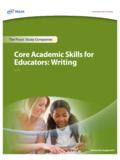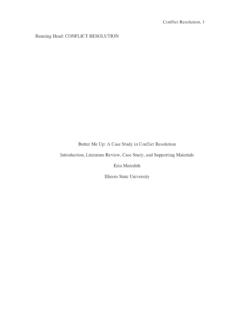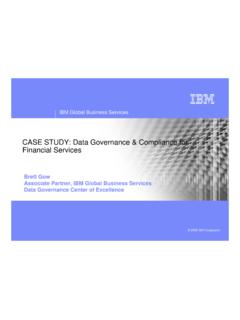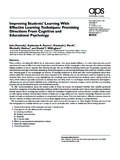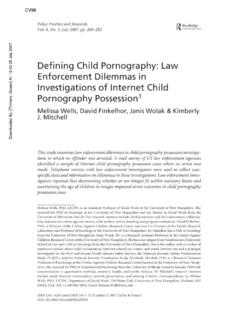Transcription of BLEND Custom Parfum: An MBA case study - AABRI
1 Journal of Business Cases and Applications Volume 19 BLEND Custom parfum , Page 1 BLEND Custom parfum : An MBA case study Lane Boyte-Eckis Troy University ABSTRACT An integrative case study is shown to improve student learning outcomes, increase retention, improve performance and engagement of students, and more effectively market a school s program. The Masters of Business Administration (MBA) degree is part of an intensely competitive industry, therefore to gain an advantage, utilizing case studies that focus on connecting real-world businesses to the student and enabling them to act as consultants provides an edge to one s program. The goal of this case study is to effectively show how a professor can integrate the evolving requirements of employers alongside the needs of students.
2 This partnership belongs within a student s program of study and the outcomes produced offer a unique way to combine theory with an increased opportunity for employment. Keywords: MBA, case study , perfume market, retention, performance, learning outcomes. Note: This case is factual and is intended for instructional and educational purposes only. The goal of this study is to highlight ways a professor can integrate a real-world business into an MBA course. Copyright statement: Authors retain the copyright to the manuscripts published in AABRI journals. Please see the AABRI Copyright Policy at Journal of Business Cases and Applications Volume 19 BLEND Custom parfum , Page 2 INTRODUCTION The trend is strong towards a student s desire to obtain a Master s Degree in Business Administration (MBA).
3 Approximately fifty-two percent of students around the world are interested in pursuing an MBA (Clinton, 2016). While many schools have experienced a decline in their new enrollment figures for a traditional two-year MBA program (Moules, 2016), the online programs retain their increased volume of applications (Moules, 2016). The flexibility online programs affords the student have generated a number of tailored programs offered by all types of institutions thus intensifying the competition within this industry. Of the 758,708 Master s degrees conferred in the 2014-2015 academic year by postsecondary institutions, 185,222 degrees were in the field of business, Secondly, the field of education, conferred 146,561 degrees, ; and, third, health professions and related fields conferred 102,897 degrees, , (NCES, 2016).
4 Over sixty-five percent of students indicated their preference for a master s degree in business was to increase their available job opportunities. And, over seventy percent of prospective students worldwide prefer to study in the (Clinton, 2016). In terms of prospective students and their selection of a program, the following factors play a dominant role: school websites, friends and family, published rankings, current students, alumni, and admissions professionals, (Byrne, 2015). Quality and reputation are the two most important factors when choosing a final program of study (Clinton, 2016, Nick & Plato, 2016). The highest cited reason for not seeking entry into a master s program is the reluctance to incur a large amount of financial burden (Bair, 2016, Clinton, 2016).
5 However, fifty-two percent of businesses do offer some type of tuition assistance at the post-secondary level, through scholarships or reimbursements (Miller, 2016). Hence, the evidence is strong for an institution to improve its offerings to meet this large market of students seeking a MBA. However, the approach that worked years ago, will not suffice in the current market. Cookie-cutter programs are producing look-alike MBAs, contemporary companies want creative, collaborative thinkers and leaders, (Doria, Roznanski, & Cohen, 2003). As quoted by Mr. John Reed, chairman of Citicorp, upon winning the Academy of Management s Distinguished Executive of the Year award in 1999, ended his acceptance speech by challenging his audience of elite academicians, The business community knows full well that business schools perform a useful function [in] sorting potential hires, he said.
6 The schools sort out from the general population those who are more ambitious, more energetic, the real question is: Do you give these students a set of skills that is going to serve them well over their careers? (Reed, 1999). While a complete reform of one s MBA program may be daunting the risks of not offering your student s what their employers are demanding is a disservice as a higher educational institution. Doria, Rozanski, and Cohen (2003), and Pande (2013) offer six general areas of reform that business schools should focus on: first, business schools should require more courses in communication, leadership, human resources, psychology, and other fields that provide graduates with skills vital to effectively managing people within team-driven organizations.
7 Second, business schools should introduce and emphasize courses that offer basic skills and tools needed in problem solving. These include data gathering, data analysis, and innovative problem-solving methodologies and tools. Third, more and better grounding in theory theories of economics, measurement, governance, human behavior, and leadership would help students go beyond case studies to analyze problems and craft solutions in situations they have never before encountered. If students learn the essentials of microeconomics, for example, Journal of Business Cases and Applications Volume 19 BLEND Custom parfum , Page 3 they may be more prepared, say, to develop a winning pricing strategy. Fourth, schools should make changes in their curricula so students can integrate their learning and apply multiple disciplines on the job.
8 Instead, students are usually forced to learn about each of the fundamental business disciplines (such as finance, strategy, operations, and marketing) in a silo-like fashion. Fifth, schools should encourage students to take full advantage of courses outside the traditional core curriculum. And, lastly, and perhaps most critically, schools should commit themselves to re-creating differentiation in their curricula. Although it may be too risky for a school today to completely leave the mainstream, MBA programs can still allow students to concentrate on an industry. While these key areas of reform are enticing and many professors agree students prefer a more specialized niche program, how does a university limited by faculty and financial resources equip students with the opportunities for success, without highly inflating tuition costs?
9 The case study that follows will illustrate how a tangible, real, business case analysis can easily be adapted into any general MBA course curriculum. This case was utilized in a Managerial Economics course at the graduate level and highlighted the importance of market models, elasticity of demand, pricing strategies, production, growth, and economic profits. The alignment of the theoretical concepts in this course with the outcomes of the case analyses were remarkable. In addition, studies of this type hit on each of the six points of reform noted by Doria, Rozanski, and Cohen, (2003), and Pande (2013). This case study forced students to communicate with a business owner one-on-one, while oftentimes through electronic means, nevertheless the aspect of communicating was present and the perfume industry took many students outside their proverbial comfort zone and forced critical thinking alongside thorough research methods.
10 The case directly aligned theories in economics with the assignment so the student witnessed directly how the concepts evolved in the business world. The implementation of these changes does not have to be one of massive overhaul, rather, one of creativity, critical thinking, and networking on the parts of both professors and students alike. This study will illustrate the benefits of partnering with an entrepreneur and the multitude of benefits both the student and the firm receive. LEARNING OBJECTIVES 1. Students will hone in their research skills at the graduate level by delving into the Custom perfume market at both the domestic and international level. 2. Students will apply their knowledge of the four main market models in conjunction with the specific business.











